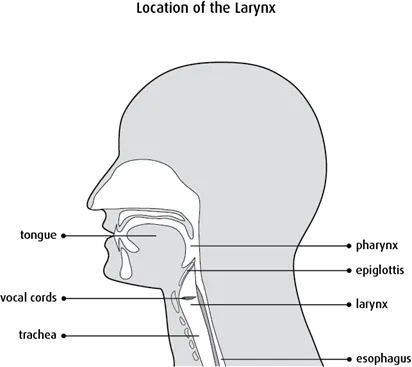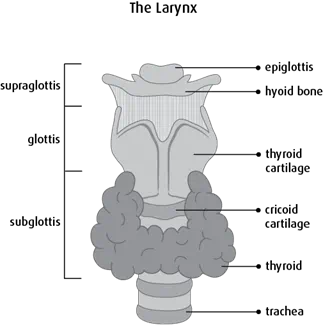What is laryngeal cancer?
Laryngeal cancer starts in the cells of the larynx (voice box). A cancerous (malignant) tumour is a group of cancer cells that can grow into and destroy nearby tissue. It can also spread (metastasize) to other parts of the body.
The larynx is part of the respiratory system. It is the tube that connects the throat to the windpipe (trachea). The vocal cords are 2 bands of muscle in the middle of the larynx that make sounds and help you speak. The larynx helps keep food and fluids from entering the windpipe. The larynx plays an important role when we breathe, swallow and speak.
Cells in the larynx sometimes change and no longer grow or behave normally. These changes may lead to non-cancerous (benign) conditions such as chronic laryngitis and vocal cord nodules. They can also lead to non-cancerous tumours such as vocal cord polyps and laryngeal papillomatosis.
Changes to cells of the larynx can also cause precancerous conditions. This means that the abnormal cells are not yet cancer but there is a higher chance that they will become cancer. The most common precancerous condition of the larynx is dysplasia.
But in some cases, changes to laryngeal cells can cause cancer. Most often, laryngeal cancer starts in flat, thin cells called squamous cells. These cells cover the inside of the larynx. This type of cancer is called squamous cell carcinoma of the larynx. Laryngeal cancer can develop anywhere in the larynx. It often starts in the middle of the larynx, close to the vocal cords. Most squamous cell cancers begin as dysplasia.
Rare types of laryngeal cancer can also develop. These include minor salivary gland cancers, sarcomas, melanomas and lymphomas.
The larynx
The larynx (also called the voice box) is part of the respiratory system. The larynx is in front of the esophagus (the tube leading to the stomach). It connects the throat (pharynx) to the windpipe, which leads to the lungs.

Structure
The larynx is about 5 cm (2 inches) long and is made up of cartilage, ligaments (connective tissue) and muscles. It is divided into 3 regions:
The supraglottis is at the top of the larynx, above the glottis. The main structure of the supraglottis is a flap of movable cartilage called the epiglottis.
The glottis is the middle part of the larynx. The glottis contains the vocal cords (sometimes called the vocal folds). The vocal cords are a pair of muscles on each side of the opening to the windpipe. They are covered with mucous membranes.
The subglottis is at the bottom of the larynx, between the glottis and the windpipe.
Most of the larynx is made up of cartilage. The thyroid cartilage forms the front and side walls of the larynx. It has a large bump that can be easily felt on the neck and is commonly called the Adam’s apple.
The cricoid cartilage is a ring of cartilage that sits below the thyroid cartilage and connects the larynx to the windpipe. The cricoid and thyroid cartilage protect the glottis and the opening to the windpipe. The epiglottis is attached to the thyroid cartilage and hyoid bone and protects the opening to the glottis. The hyoid bone is U-shaped and connects to the larynx by a piece of ligament. Several muscles and ligaments attached to the hyoid bone help to support the larynx and move it and the tongue during swallowing and speech.

What the larynx does
The larynx has 3 main functions.
Breathing
The epiglottis and vocal cords open naturally during breathing to allow air to move in and out of the lungs through the windpipe. A cough reflex is triggered if food or liquid enters the larynx.
Swallowing
The muscles and ligaments around the larynx stop food or liquid from entering the windpipe and lungs during swallowing. When you swallow, these muscles move the larynx up. This causes the epiglottis to close over the top of the larynx. It also helps move food from the mouth to the esophagus.
Speaking
The larynx produces sound for speaking as we breathe out air from the lungs. Sound is produced when air passes through the larynx and vibrates the vocal cords. The muscles of the vocal cords expand and contract to change the volume and pitch of the voice. As you push air up through the larynx and out through the mouth, you create the different sounds of speech by moving your teeth, tongue and lips.
Cancerous tumours of the larynx
Precancerous conditions of the larynx
Non-cancerous tumours of the larynx
Non-cancerous conditions of the larynx
Your trusted source for accurate cancer information
With support from readers like you, we can continue to provide the highest quality cancer information for over 100 types of cancer.
We’re here to ensure easy access to accurate cancer information for you and the millions of people who visit this website every year. But we can’t do it alone.
Every donation helps fund reliable cancer information, compassionate support services and the most promising research. Please give today because every contribution counts. Thank you.
